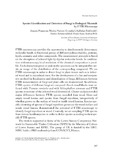Mostrar el registro sencillo del ítem
Species identification and detection of fungi in biological materials by FTIR microscopy
| dc.creator | Naumann, Anette | es_ES |
| dc.creator | Navarro González, Mónica | es_ES |
| dc.creator | Peddireddi, Sudhakar | es_ES |
| dc.creator | Schützendübel, Andres | es_ES |
| dc.creator | Kües, Ursula | es_ES |
| dc.creator | Polle, Andrea | es_ES |
| dc.date.accessioned | 2018-02-15T10:32:24Z | |
| dc.date.available | 2018-02-15T10:32:24Z | |
| dc.date.issued | 2006 | |
| dc.identifier.isbn | 84-9769-107-5 | |
| dc.identifier.uri | https://hdl.handle.net/2454/27268 | |
| dc.description | Resumen del poster presentado al VI Meeting on Genetics and Cellular Biology of Basidiomycetes (GCBB-VI), organizado por y celebrado en la Universidad Pública de Navarra el 3-6 de junio de 2005. | es_ES |
| dc.description.abstract | FTIR spectroscopy provides the opportunity to simultaneously detect many molecular bonds or functional groups of different polysaccharides, proteins, lipids, aromatic and other compounds. The measurement principle is based on the absorption of infrared light by dipolar molecular bonds. In combination with microscopy, local resolution of the chemical composition is possible. Each absorption point or peak in the spectrum can be integrated to create an image of the distribution of the corresponding compound. We use FTIR-microscopy in order to detect fungi in plant tissues such as in infected wood and in mycorhizal roots. For the development of a fast and inexpensive method for localisation and identification of fungi, differences between FTIR measurements of fungi and plant cells are characterized. In addition, FTIR spectra of different fungi are compared. Beech wood blocks were infected with Trametes versicolor and with Schizophyllum commune and FTIR spectra in sections of the infected wood determined. Cluster analysis revealed major differences between FTIR spectra recorded from wood fibres and empty vessel lumina and spectra from fungal mycelium, irrespectively of whether grown on the surface of wood or inside vessel lumina. Species specific clustering of spectra of fungal mycelium grown on the wood surface and inside vessel lumina demonstrated the potential of FTIR microscopy to identify fungal mycelium in wood. Currently, we are sampling FTIR spectra from various basidiomycetes in order to define species according to their specific FTIR spectra. The work is supported in frame of the Lower Saxony Competence Network for Sustainable Timber Utilisation (NHN) by the Ministry of Culture of Lower Saxony and EFRE. The group of UK is funded by the DBU. MNG holds a PhD studentship from CONACYT, Mexico. | en |
| dc.description.sponsorship | The work is supported in frame of the Lower Saxony Competence Network for Sustainable Timber Utilisation (NHN) by the Ministry of Culture of Lower Saxony and EFRE. The group of UK is funded by the DBU. MNG holds a PhD studentship from CONACYT, Mexico. | en |
| dc.format.extent | 1 p. | |
| dc.format.mimetype | application/pdf | en |
| dc.language.iso | eng | en |
| dc.publisher | Universidad Pública de Navarra / Nafarroako Unibertsitate Publikoa | es |
| dc.relation.ispartof | Antonio G. Pisabarro and Lucía Ramírez (eds.): VI Meeting on Genetics and Cellular Biology of Basidiomycetes (GCBB-VI). Pamplona: Universidad Pública de Navarra / Nafarroako Unibertsitate Publikoa, 2006. | es |
| dc.rights | © Autores; Universidad Pública de Navarra. Esta publicación no puede ser reproducida, almacenada o transmitida total o parcialmente, sea cual fuere el medio y el procedimiento, incluidas las fotocopias, sin permiso previo concedido por escrito por los titulares del copyright. | es_ES |
| dc.subject | FTIR microscopy | en |
| dc.subject | Species identification | en |
| dc.subject | Detection of fungi | en |
| dc.title | Species identification and detection of fungi in biological materials by FTIR microscopy | en |
| dc.type | info:eu-repo/semantics/conferenceObject | en |
| dc.type | Contribución a congreso / Biltzarrerako ekarpena | es |
| dc.rights.accessRights | info:eu-repo/semantics/openAccess | en |
| dc.rights.accessRights | Acceso abierto / Sarbide irekia | es |
| dc.type.version | info:eu-repo/semantics/publishedVersion | en |
| dc.type.version | Versión publicada / Argitaratu den bertsioa | es |


